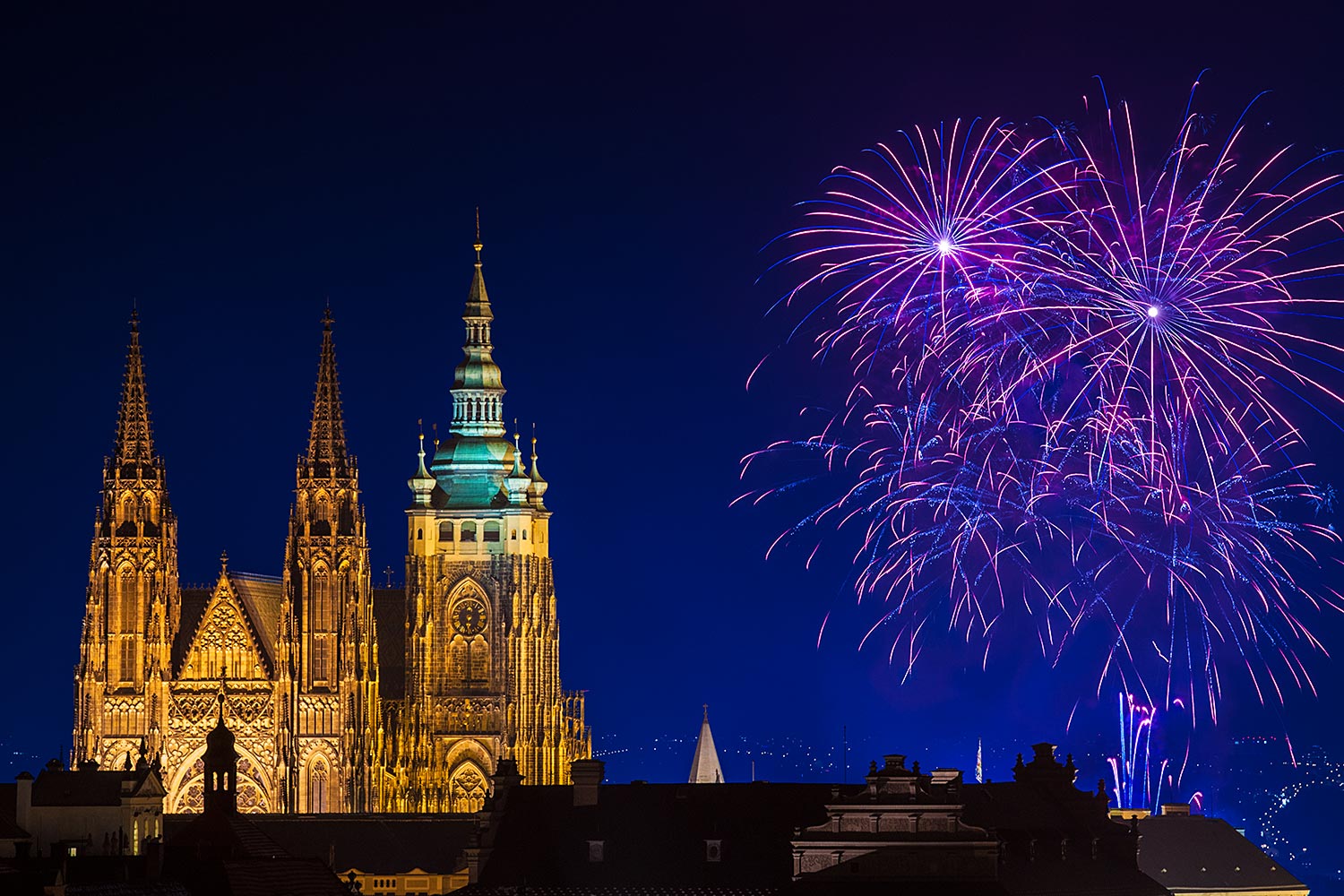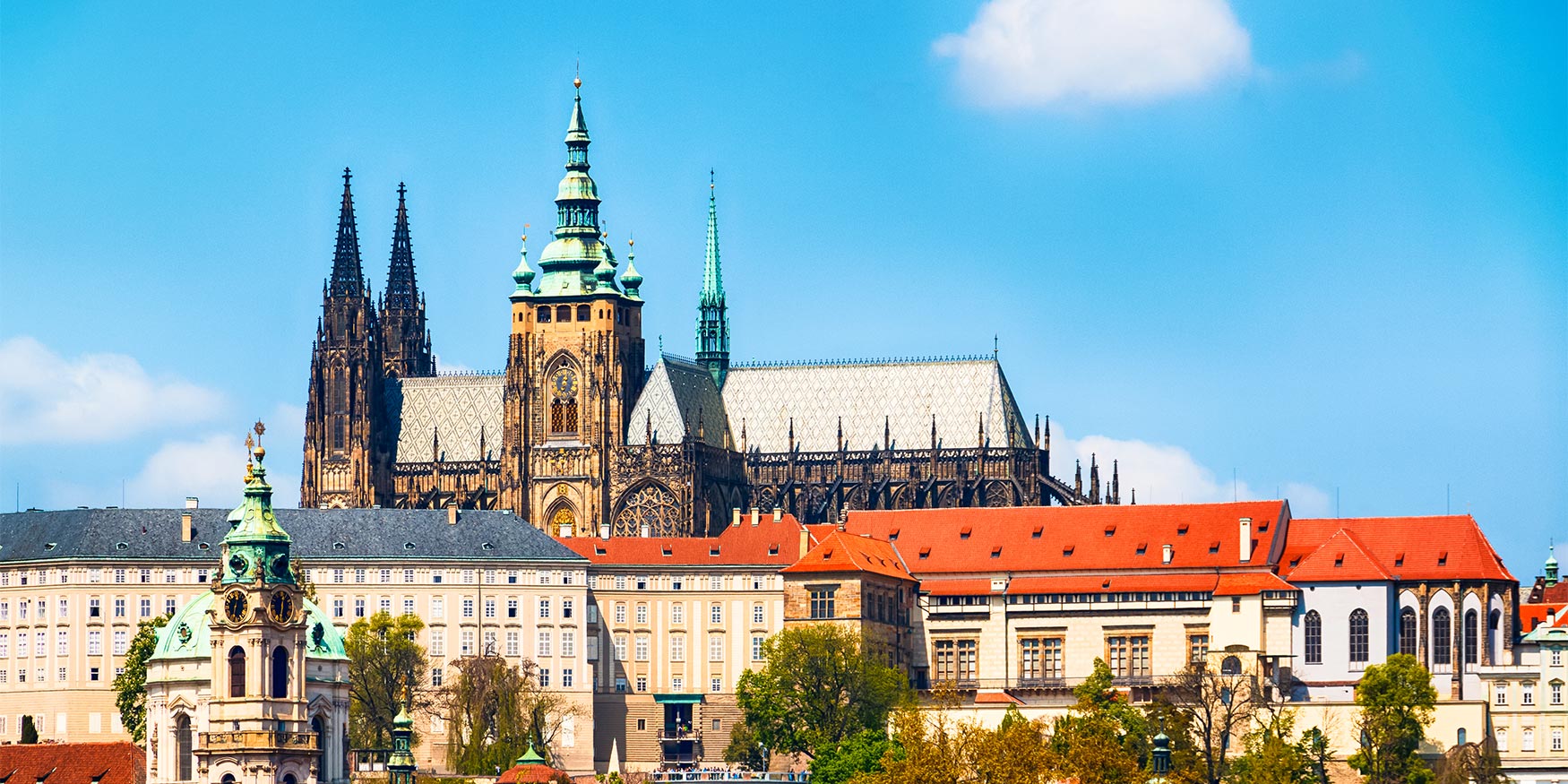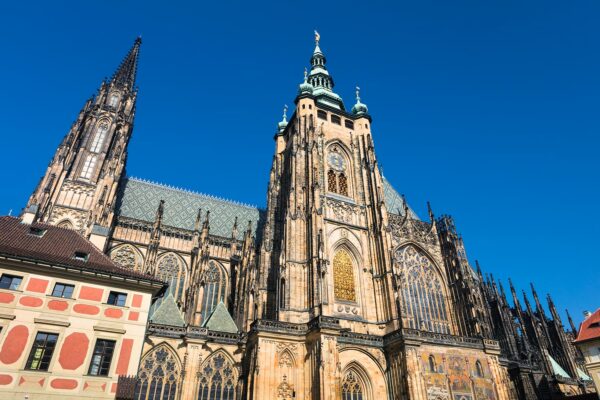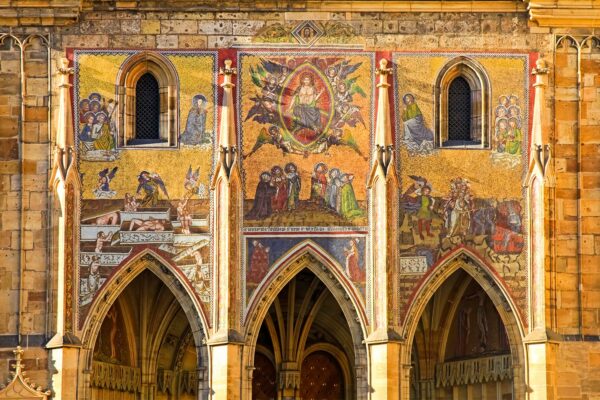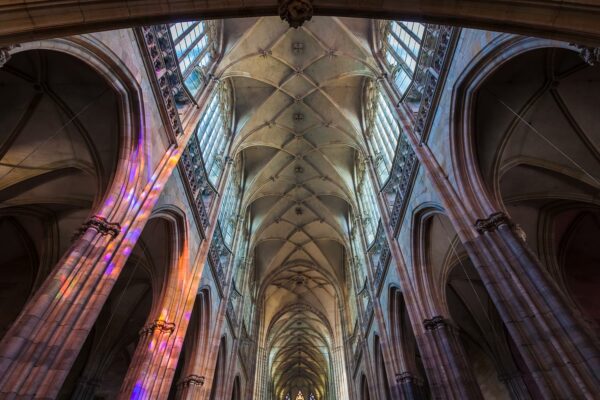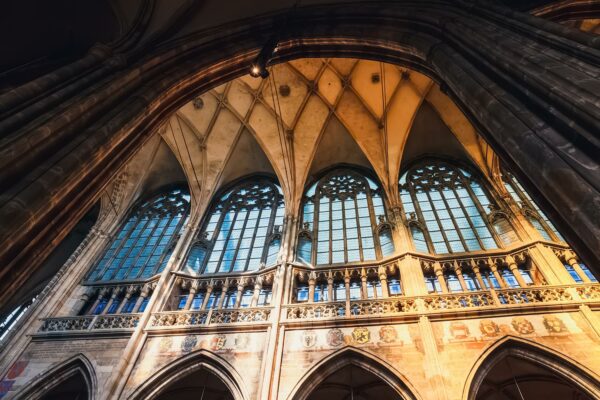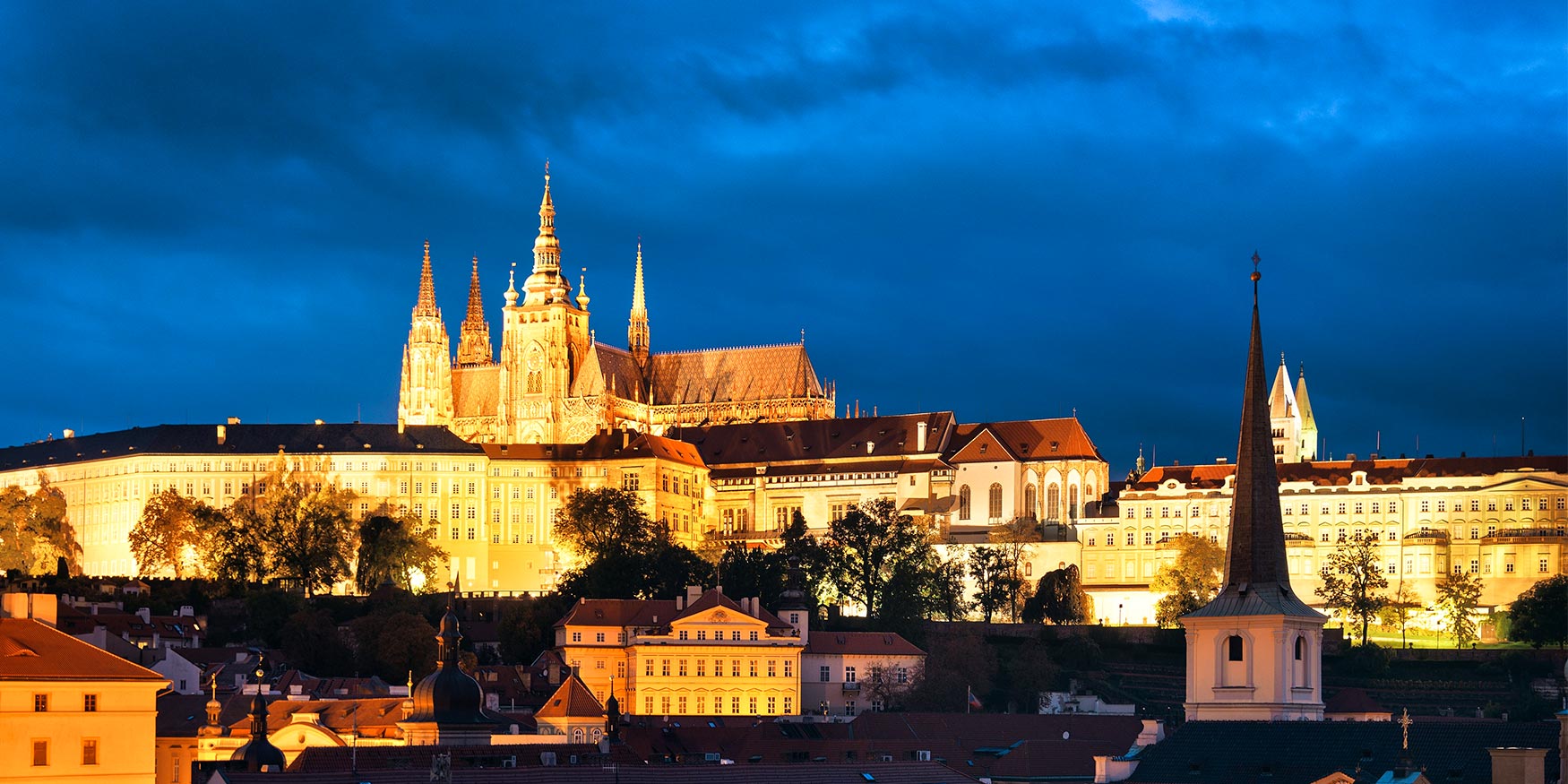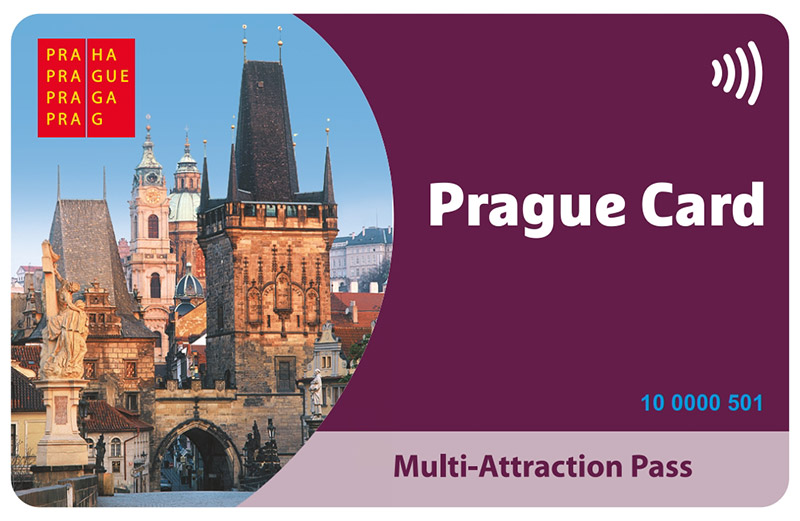St Vitus Cathedral is a Roman Catholic shrine located within the premises of Prague Castle, towering above Prague’s Lesser Town. By its full name, it’s referred to as the Metropolitan Cathedral of Saints Vitus, Wenceslaus and Adalbert (in Czech: Katedrála svatého Víta, Václava a Vojtěcha).
Say the name Prague and a vision of the St Vitus Cathedral immediately springs to mind. It’s undoubtedly one of the most remarkable and recognisable landmarks in Prague and the whole of Czechia.
The cathedral is much more than just an enchanting place of Christian worship and spiritual retreat. We can only describe it as a work of unparalleled art and an awe-inspiring, treasure-filled sight. Seeing it with own eyes is an experience of a lifetime.
St Vitus Cathedral is known as one of the most important shrines in the country and a spiritual symbol of the Czech state. With 122 metres (400 feet) in length, 60 metres (197 feet) in width and 33,2 metres (109 feet) ceiling height, it’s the largest church in Czechia and among the largest churches in Europe.
Since the 10th century, St Vitus Cathedral has been the seat of the bishop of the Prague diocese (elevated to an archdiocese in 1344). Apart from an uncountable number of masses and other Catholic ceremonies, the coronations of many Czech kings and queens took place here. It serves as a final resting place for numerous saints, monarchs, nobles and archbishops. In 2011, it was the venue of the state burial of Václav Havel, former Czech and Czechoslovak leader.
History & Design
The temple is the 3rd church dedicated to St Vitus built on the same site. Around the year 925, a pre-Romanesque rotunda was founded here by Wenceslaus I, Duke of Bohemia and the Patron Saint of the Czech state. In 1060, under the reign of Spytihněv II, the Rotunda was replaced by a three-nave basilica with two towers.
King John of Bohemia (in Czech known as Jan Lucemburský) laid the foundation stone for the new Gothic cathedral in 1344. Construction continued during the rule of his eldest son and heir to the throne Charles IV. During these times, Prague was the seat of the Holy Roman Emperor, making it one of the most important centres of culture and arts in whole medieval Europe. The city saw massive development. Prague and the Czech lands are embellished with many iconic architectural gems built at that time, including the Charles Bridge or Karlštejn Castle.
St Vitus Cathedral's first two architects – Matthias of Arras and Peter Parler - built a choir with several chapels framing the nave, the St Wenceslas Chapel, the Golden Gate and the lower part of the Great South Tower. In the 18th century, the tower was topped out after the finalisation of the current dome.
However, the lengthy construction was interrupted in 1419 by the Hussite Wars and, although some rulers tried to make progress, the church remained unfinished for many centuries. It was not until the second half of the 19th century that the completion of the shrine in neo-Gothic style was initiated by the Union for the Completion of the St Vitus Cathedral.
The neo-Gothic part of the cathedral consists of the central nave and narrow side naves lined with numerous chapels. The interior is subtly illuminated by light pouring through the stunning coloured windows, further amplifying the mystical ambience of this place. At the turn of the 19th and 20th centuries, the western nave and two towers in the original Gothic style were built. Finally, in 1929, the cathedral was solemnly consecrated. Almost 600 years after the construction works began. However, we can acknowledge it was worth the wait.
Highlights
St Wenceslas Chapel
The cathedral abounds with many marvellous features you can admire. The most iconic one is undoubtedly the St Wenceslaus Chapel. It was designed by Peter Parler - a profound architect of German descent. As the name suggests, the Chapel is dedicated to St Wenceslas and it's also his final resting place.
The lower part of the Chapel’s interior is adorned with paintings depicting the Passion cycle, studded with gemstones in gilded plaster. It forms part of the original decoration of the chapel from the 14th century. The second strip of decoration (with origin in the 16th century) depict scenes from the life of St Wenceslas. They are credited to the workshop of the Master of the Litoměřice Altar.
The door in the southwest corner of the chapel is guarding the staircase leading to the Crown Jewels Chamber, where a collection of inestimable value is stored - the Bohemian Crown Jewels. There are seven locks on the door, and the keys are entrusted to seven representatives of the state, the Catholic Church and the city (the President of the Republic, the Prime Minister, the Chairman of the House of Deputies, the Chairman of the Senate, the Lord Mayor of Prague, the Prague Archbishop and the Dean of the Metropolitan Chapter of St. Vitus Cathedral).
Golden Gate
The marvellous Golden Gate forms the arcaded vestibule of the ceremonial southern entrance to the shrine. Its upper floor hosts the Crown Jewels Chamber safekeeping the Bohemian Crown Jewels. The gate owes its name to the golden background of the magnificent glass mosaic of the Last Judgment decorating its façade since the 14th century.
Great South Tower
With almost 100 metres in height, the Great South Tower is the tallest of the three large towers of the St Vitus Cathedral. The observation gallery situated 56 metres above the ground offers unparalleled photo opportunities and spectacular views of the city below you. While ascending the 287-steps-long stone staircase up to the top, you will be able to view the bell chambers. The largest bell is called Zikmund, and it weighs approximately 15 metric tonnes. Please bear in mind that access to the Great South Tower may be restricted in case of bad weather.
Stained glass windows
St Vitus Cathedral would be incomplete without its outstanding, vibrantly coloured windows. The western wall of the nave, above the main entrance, is where the colossal Rose Window is placed. This window depicts the Biblical creation of the world. Windows in the northern part of the nave were designed by the famous Czech Art Nouveau painter Alfons Mucha. The largest artistically rendered temple window in Czechia is called the Last Judgement, and it can be observed on the nave’s south side. It’s the work of Max Švabinský – one of the most notable Czech artists of the 20th century.
Visiting the St Vitus Cathedral
You can find the entrance on the third courtyard of Prague Castle, opposite the passage between the second and the third courtyard. The bronze entrance doors are ornamented with reliefs showing scenes from the history of the church and the legends of St Wenceslas and Adalbert.
For information about regular masses, visit the official webpage of the St Vitus Cathedral.
Search for opening hours here.
Getting There
The nearest public transport stations are:
Metro (subway) – Malostranská station (Line A – the green line),
Bus – Šporkova station (Line no. 194, request stop),
Tram – Malostranské náměstí station (Lines no. 12, 15, 20, 22 and 97).
Are you are a wheelchair user, or you happen to carry a baby stroller? Or perhaps you want to save some precious time and energy? Then it might be easier for you to proceed to the Pohořelec tram station (Lines no. 25, 32, 35 and 97). The station is settled directly on the hilltop of Hradčany, so you won’t need to climb the hill where the Prague Castle complex with the St Vitus Cathedral is situated.


